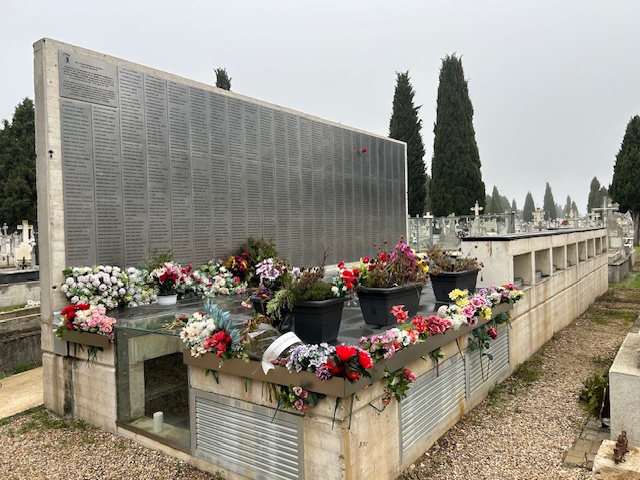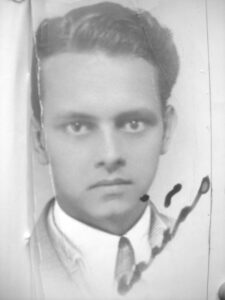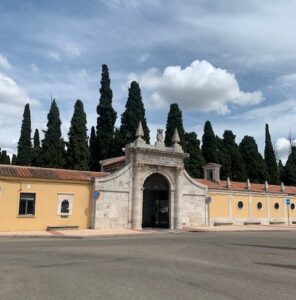From Puerto Rico to Spain: The Search for Carmelo Delgado
Carmelo Delgado, a Puerto Rican law student in Madrid, fought as a militiaman on the Republican side until he was taken prisoner by the rebel forces and shot. Can his remains be recovered?
In their moving graphic novel El abismo del olvido, which deals with the aftermath of the Spanish Civil War, Paco Roca and Rodrigo Terrasa recall a fascinating anecdote. The archaeologists of Egyptian tombs, they write, believed that when the bodies were exhumed from the burial chamber, their souls were freed from the “abyss of oblivion”—el abismo del olvido—where they were trapped for thousands of years. We felt something similar on December 17, 2023, when we visited the El Carmen cemetery in Valladolid with Jaime Silva, a nephew of Carmelo Delgado, who had been shot and buried there on April 11, 1937. For many years, no one knew where his grave was, until it was finally found and opened in 2022. After 85 years, Carmelo was free.
A native of the town of Guayama, Puerto Rico, Carmelo Delgado Delgado was a law student at the Central University of Madrid when the military uprising against the legitimate government of the Spanish Republic broke out on July 18, 1936. He fought as a militiaman on the Republican side until he was taken prisoner by the rebel forces on November 4, 1936, at Alcorcón, southwest of Madrid. On February 16, 1937, Carmelo was sentenced to death for the crime of “adherence to the rebellion” and executed by firing squad on April 10, 1937, along with Joaquín Pardo García and Paulino Ontalvilla Gil, and buried in a mass grave. (For more on Puerto Rican volunteers in Spain, see our book Voluntarios de la Libertad. Puertorriqueños en defensa de la República Española, 1936-1939, just published in a second edition.)
We traveled to Valladolid on a chilly winter day, under a dense fog, typical of the region, along with Jaime Silva, the nephew, and two local members of the Association for the Recovery of the Historical Memory (ARHM), president Julio Del Olmo and secretary José Miguel Fuertes Zapatero. As the cold got to our bones, we thought about Carmelo’s suffering and loneliness, as a prisoner far from his family and loved ones. We visited the building that housed the New Prison (Cárcel Nueva) where he spent his last days, and the Narciso Alonso Cortés schoolyard, the old Campo de San Isidro where he was executed. We walked along the cemetery path where the mass graves were found, admired the Memorial inaugurated in 2020 that holds the exhumed remains of more than four hundred victims, and stood in front of mass grave #6, at lot #63, where Carmelo was buried.
The search for Carmelo’s remains began with his mother, Flora Delgado González, in the 1960s. During a visit to the cemetery of Valladolid the officials told her that “the graves of those who had been retaliated and shot had been opened, and the remains thrown into the common ossuary to make way for new graves and pantheons.” Fifty years later, in 2017, one of his nephews who visited the Valladolid cemetery looking for his uncle’s remains got the same answer. He went back home with the sad news that “most probably, we will never find Carmelo.” However, an employee of the Municipal Archives shared the documentation they had about his uncle, including an unidentified photo that was part of the trial records. One of his sisters confirmed that the photo was Carmelo’s.
For our part, we learned about the first excavations of mass graves in El Carmen cemetery at the end of 2019, and asked ARHM if the remains of Carmelo Delgado were among the exhumed bodies from grave #6. The response of Francisco Redondo, member of ARHM, was not encouraging. He said they could not be sure if Carmelo’s remains had been exhumed or transferred, given the lack of documentary records. Worse, he added, no new exhumations were going to be possible. Three years later, however, hope returned.
Valladolid’s Association for the Recovery of Historical Memory was founded in 2002 to study the repression by the military rebels and to search for the remains of their victims during the war in Valladolid region. Since then, the Association has exhumed more than 1,000 bodies from forty mass graves. The search for ten mass graves in El Carmen cemetery began at the end of 2015, at the places indicated by relatives of the victims and by former gravediggers, near lots #58 and #63. This was the boundary of the cemetery in 1940 and a place of remembrance where, for years, the relatives of the dead had been placing flowers and headstones. It was precisely in this area where, in 1980, the Spanish Socialist Workers’ Party (PSOE) and the General Union of Workers (UGT) inaugurated two monuments in honor of the victims of the Spanish Civil War. During 2016 and 2017, with the help of the city council, and often using its own resources, the ARHM exhumed 247 bodies with bullet wounds, some in the chest, others all over the body, including bullet ridden craniums.
In 2019 a Memorial was built at the cemetery to replace one of the older monuments. The exhumated remains of the victims of Francoism were stored in the vault, under storage conditions that ensure their conservation to allow future forensic investigations. The names of 2,647 victims from Valladolid were engraved on the walls of the Memorial, including Carmelo Delgado Delgado.
In 2017, ARHM discontinued the search for other mass graves at El Carmen until, “by a stroke of luck,” they found an old map of the cemetery that read “Fosas de fusilados” (mass graves of executions) at lot #63, in the area where PSOE and UGT’s monuments were located. They also found an aerial photo from the beginning of the war showing an off-white color in that area, which suggested earthwork. ARHM began excavating the area in March 2022. Very soon, close to the surface, thousands of bones from the ossuary appeared. Farther down, at a depth of sixteen inches, the archeologists found the first victims’ remains. The first mass grave excavated that year was grave #6: it was used by the rebels between January 30 and April 23, 1937. The grave contained 73 bodies with gunshot wounds.
The bodies in mass grave #6 were placed side by side, in the same order in which they were shot after court martial, meaning that the upper levels in the grave correspond to the last people shot. Each level was separated by a layer of lime and soil, which facilitated the recovery and evaluation of the remains. There were few personal belongings in the grave because those who were sentenced to death left what little they had to their cellmates. Still, many carried a spoon for their meal. The archeologists also found pieces of a Civil Guard uniform, a button with the initials GC and sections of a coat, belt, straps, and insignia of an Artillery uniform. These findings, when compared with documents from courts martial and executions at the Ferrol Military Archive, allowed the researchers to conclude that Civil Guard Martín Sevillano Soblechero and Artillery Corporal Eugenio García Ortega were buried in grave #6.
In March 2023, when we heard that the excavation of mass grave #6 was completed, we contacted the ARHM again to inquire about Carmelo Delgado’s remains. His nephew did the same in April. He received an answer a month later: the ARHM replied that Carmelo’s remains may be among those in grave #6. As it turned out, among the 73 bodies found in grave #6 there were three male corpses placed side by side at a depth of five feet—probably buried a few weeks before the mass grave was closed—that matched Carmelo Delgado Delgado’s burial date. According to the forensic analysis performed on the remains, two of them were between 30 and 40 years old when they died, and the other between 20 and 30. Carmelo was 24 years old when he was shot, while Joaquín Pardo García and Paulino Ontalvilla Gil were 34. Therefore, Del Olmo, the ARMH president, was “almost certain” that these are Carmelo’s remains and suggested a DNA test for confirmation.
The remains, identified as body #21 from grave #6, now rest in the vault beneath the Memorial, awaiting confirmation of his identity. If they are confirmed to be Carmelo Delgado’s, they would be the first to be recovered and identified among fifteen Puerto Ricans who fought and died heroically for the Spanish Republic.
Teresita Torres Rivera and José Alejandro Ortiz Carrión are the authors of Voluntarios de la Libertad. Puertorriqueños en defensa de la República Española, 1936-1939 (2nd edition, 2023).















